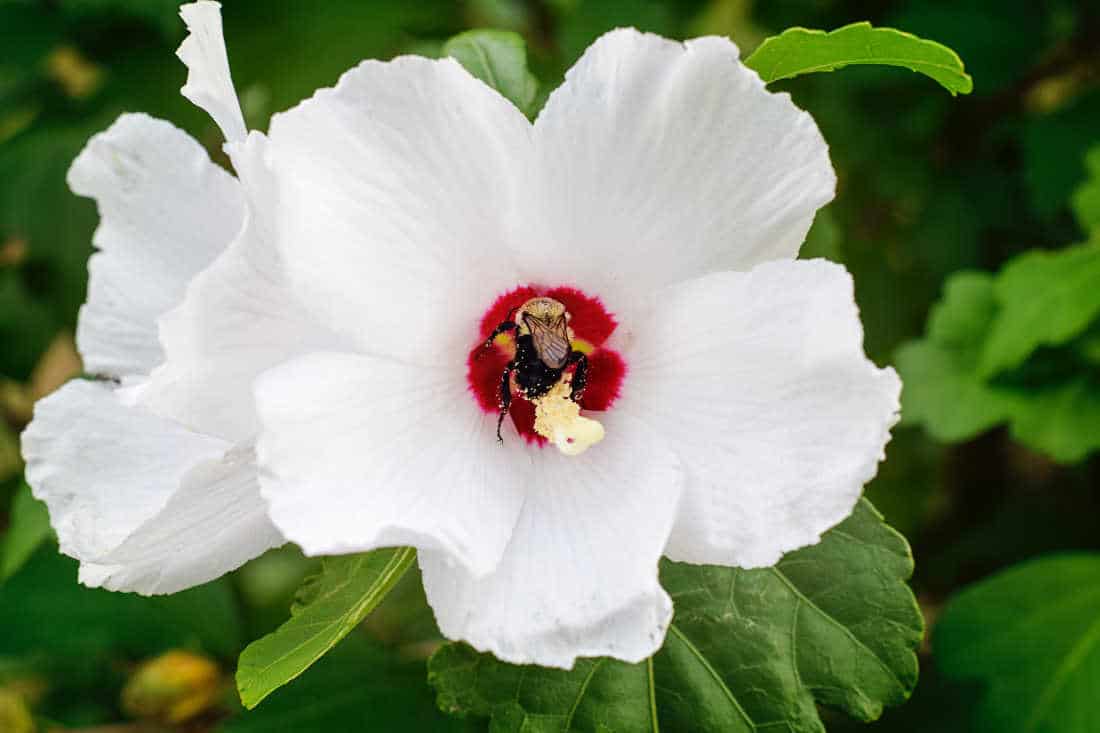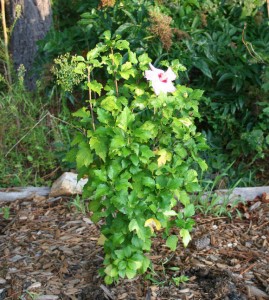Growing rose of sharon isn’t difficult. My friend gave me a seedling from her plant, and my rose of sharon bush is thriving on benign neglect.
The Rose of Sharon Bush
The Rose of Sharon is a flowering bush that blooms in late summer and early fall, offering a flowering shrub in the landscape when most other flowering shrubs like azaleas are finished for the season.
Rose of Sharon is also a fast-growing shrub and often attains heights of 6 to 10 feet tall. It can be used as a landscape plant, a flowering screening shrub, or an accent plant in the garden.
The bush is easily cared for and relatively low maintenance, except for yearly pruning to keep it from overtaking your garden. The Rose of Sharon offers gardeners in zones 6 through 10 a useful and beautiful addition to the garden.

Which Rose of Sharon?
The name Rose of Sharon is what gardeners call the common name for the plant. Like many common names, it can refer to several species. Typically people mean Hibiscus syriacus, the Latin name for the Rose of Sharon flower that’s found in gardens throughout the United States. This article refers to Hibiscus syriacus whenever it mentions Rose of Sharon.

Growing Rose of Sharon
Hibiscus syriacus or Rose of Sharon is native to eastern Asia, and as such, it does well in a similar climate, such as what is found in the United States along the eastern seaboard and throughout the mid-Atlantic and southeastern United States. Growing Rose of Sharon in the home garden in these areas is usually easy.
Follow these tips for successfully growing Rose of Sharon:
- Plant in full sun or partial sun. Your bush needs at least 4 or more hours of direct sunlight per day. It can tolerate some light afternoon shade.
- Give the plants plenty of space. If you’re planting more than one Rose of Sharon, leave at least 6 to 10 feet between the plants. At first, it’s going to look like a lot of space, but as you’ll see, the bush grows quickly and will easily fill up the space.
- Prune your Rose of Sharon bush in the early spring, pruning it back to 2 or 3 buds per branch. New flowers form on new wood, so you’ll want to prune your bush before it starts growing in the spring.
- Water your bush, but don’t let it become soggy. A good layer of mulch spread 1 – 2 inches thick under the drip line of the shrub helps it conserve water and retain moisture.
- Use organic compost each spring to fertilize your plant. Simply spread well-aged manure or compost around the drip line or under the branches near the trunk. Conventional commercial fertilizers generally aren’t needed; the plants do just fine with compost.
Rose of Sharon: Colors
Rose of Sharon comes in hues of white, pink, lavender, and purple. The flowers generally resemble the hibiscus. Rose of Sharon flowers in the late summer, and well into the fall, adding beautiful flowers to your front yard or landscape at a time when typical landscape shrubs have finished flowering for the season.
Where to Buy Rose of Sharon
You can purchase Rose of Sharon plants at your favorite nursery or garden center, or visit one of the many online nurseries to find the color and plant you desire.
They grow easily from seed, and once your Rose of Sharon plant becomes established, volunteers or offspring of the parent plant may grow around the tree.
Dig them up, grow them in pots until they are several inches tall, and share them with gardening friends or add more beautiful Rose of Sharon bushes to your landscape.
How Tall Do They Get?

According to Plant Care Guides from the National Gardening Association, Rose of Sharon grow as high as 8 to 12 feet tall, so my little 2 ft plant will grow to be a giant if all goes well. Rose of Sharon are very easy care and flower abundantly in late summer and early fall, the perfect time in my garden when most other plants are finished flowering. Plant Care Guides states that Rose of Sharon produces flowers on new wood, so pruning in early spring is a must. I’ll just give this one a little gentle pruning to encourage flowers. I don’t want to cut it back too much and damage it. There are plenty of buds on it this year, and I am looking forward to more of the display from my new Rose of Sharon bush.





Great stuff…I think you’ve made some truly interesting points.Keep up the good work.
http://www.freshflowerscanada.ca/